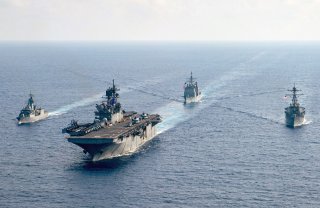Royal Navy’s Pilots Have Been Quarantined to Stop Spread of the Coronavirus
The Royal Navy is once again operating a carrier and its largest ever. The ship’s commanding officer, Captain Angus Essenhigh, is taking precautions by only allowing pilots who tested negative for the coronavirus could be allowed to land their jets on board.
The Royal Navy is now quarantining the fighter pilots who will serve on the HMS Queen Elizabeth, the new British carrier that has been undergoing sea trials in preparation for its first deployment next year. In April the UK’s Royal Navy announced that it would test each of the six hundred sailors and airmen who will be serving on the carrier as a precaution.
The ship’s commanding officer, Captain Angus Essenhigh, told the British media that only pilots who tested negative for the coronavirus could be allowed to land their jets on board. The Royal Navy is taking these extra precautions to avoid having to take “Big Lizzie”—the affectionate nickname for the Royal Navy’s newest carrier—out of service.
Earlier this year the USS Theodore Roosevelt (CVN-71) was sidelined for more than two months in Guam while its crew recovered from an outbreak of the coronavirus, while the highly infectious respiratory illness quickly spread on France’s only aircraft carrier Charles de Gaulle.
The HMS Queen Elizabeth and her sister ship, HMS Prince of Wales, which is still under construction, have been seen as an opportunity for increased cooperation among the European NATO partners and one that could transform NATO’s naval capabilities. The new carriers also mark a major turning point for the Royal Navy, which for two centuries had been among the world's most potent fighting forces and at its peak had some 332 warships. Today it has approximately thirty vessels fit for service.
Since the decommissioning of HMS Ark Royal in 2011, the Royal Navy is once again operating a carrier and its largest ever. This new class of warship is far more automated, advanced and is capable of deploying thirty-six of the new F-35B Lighting II Joint Strike Fighters.
Four of the F-35 fighters touched down on the carrier last week—and the airmen who had flown from RAF Marham in Norfolk had been in strict isolation. In addition to the pilots, some 250 engineers and other sailors jointed the carrier at Portsmouth last weekend. All were reportedly clear of the disease.
However, in April the Royal Navy removed two crew members who had tested positive for coronavirus—and the ship underwent a period of quarantine prior to taking part in its training exercises. The British Ministry of Defence has also confirmed that two Royal Navy sailors had died after contracting coronavirus but it is unclear if either of those sailors had been on the HMS Queen Elizabeth.
In total between March 1 and April 16, some 121 service personnel—including fifty-eight from the Army, thirty-four from the Navy and twenty-nine from the RAF—had fallen ill with the coronavirus. The UK has seen a steady decline in cases of coronavirus over the past month.
HMS Queen Elizabeth is scheduled to take part in operations with the U.S. Navy early next year.
Peter Suciu is a Michigan-based writer who has contributed to more than four dozen magazines, newspapers and websites. He is the author of several books on military headgear including A Gallery of Military Headdress, which is available on Amazon.com.
Image: Reuters

